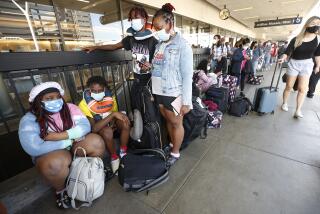âArchaicâ Treaty Will Limit Flight 103 Liability, Lawyers Say
WASHINGTON â The families of those who died in the Pan Am disaster over Scotland probably will recover only a small fraction of the damages that they would have received had their loved ones been killed while traveling within the United States.
Under an international air treaty that most lawyers and even the airlines say is archaic, the liability of the carriers generally is limited to $75,000 per passenger.
By contrast, the airlines have paid families of recent victims of U.S. air crashes an average of more than $500,000. The family of one business executive killed in a 1985 Delta Airlines crash in Dallas won a record $7.9-million verdict.
âAnachronistic Treatyâ
âThis is an anachronistic treaty that harms innocent Americans. And if we had any sense, weâd get out of it,â said Lee Kreindler, a New York attorney who represents plaintiffs suing the airlines.
The Warsaw Convention of 1929 set the first rules governing international air travel, then an infant industry. To protect the carriers from being bankrupted by an accident, their liability was limited to $8,300 per passenger.
In November, 1965, the U.S. government said that it was pulling out of the treaty because of the low liability limit. But at a hastily convened meeting in Montreal a few months later, the liability ceiling was lifted to $75,000, and U.S. officials agreed to continue observing the 130-nation agreement.
In recent years, plaintiffsâ lawyers, passenger groups, the airlines and officials of the State and Transportation departments have agreed that the limit needs to be raised or removed, but the conflicting parties have not been able to agree on new rules.
âMaybe this crash will finally do it,â said Kreindler, whose firm is representing relatives of several victims of Pan American World Airways Flight 103.
Whether the airlineâs liability is limited depends on a passengerâs ticket, not where the plane crashes.
For example, if a plane crashes upon takeoff from Los Angeles International Airport, the family of a passenger whose ticket says he is going to New York can sue the carrier for millions of dollars to replace their lost income and emotional support. But, for a passenger seated next to him whose ticket has London as the final destination, then that personâs family would be limited to $75,000.
Under the Montreal agreement, the liability limit for the international passenger can be waived only if lawyers for the survivors can prove that the accident was caused by âwillful misconductâ by the airline.
âTough Burdenâ
âItâs a pretty tough burden to meet,â said New York attorney George N. Tompkins Jr., who represents airlines in such litigation. âWe have lost a few over the past 60 years, but not many. They have to show a conscious act by the airline crew, something more than carelessness or negligence.â
Milton Sincoff, a New York lawyer who represents families in pending litigation over the 1983 Korean Airlines disaster in which Soviet jet fighters shot down a Boeing 747 that strayed into Soviet airspace, said plaintiffs can win if they show a âwillful act or omissionâ by the crew or the carrier.
While stressing that he was not involved in suits against Pan Am, Sincoff said that plaintiffsâ lawyers probably will try to show that Pan Am officials knew their security system was weak but took no action to improve it.
âWe know that there were studies done and they had specific warnings of problems in security. And they failed to take any measures to improve their security, at least until this week,â Sincoff said.
Ticket Warnings an Issue
A case pending before the Supreme Court could also affect the Pan Am litigation. The Warsaw Convention said passengers must be warned of the liability limit and the Montreal accord said the warning should be on the ticket âprinted in type at least as large as 10-point modern type.â (In comparison, most of the stories in The Times use 8 1/2-point type.)
After the Korean Airlines crash, it was discovered that several dozen passengers had tickets with warnings printed in 8-point type. Nevertheless, a U.S. judge and the appellate court in Washington ruled that this âdefectâ in the ticket does not waive the liability limit.
The families of the KAL victims appealed to the Supreme Court, which heard arguments in the case this month.
10-Point Warning
Lawyers said that Pan Amâs standard tickets contain the 10-point warning, but it is possible that some passengers were issued tickets in Europe with the warnings printed in smaller type.
If the Supreme Court rules that 10-point type is required, âyou can bet the lawyers are going to be reading a lot of ticketsâ of the Pan Am victims, Tompkins said.
More to Read
Sign up for Essential California
The most important California stories and recommendations in your inbox every morning.
You may occasionally receive promotional content from the Los Angeles Times.










